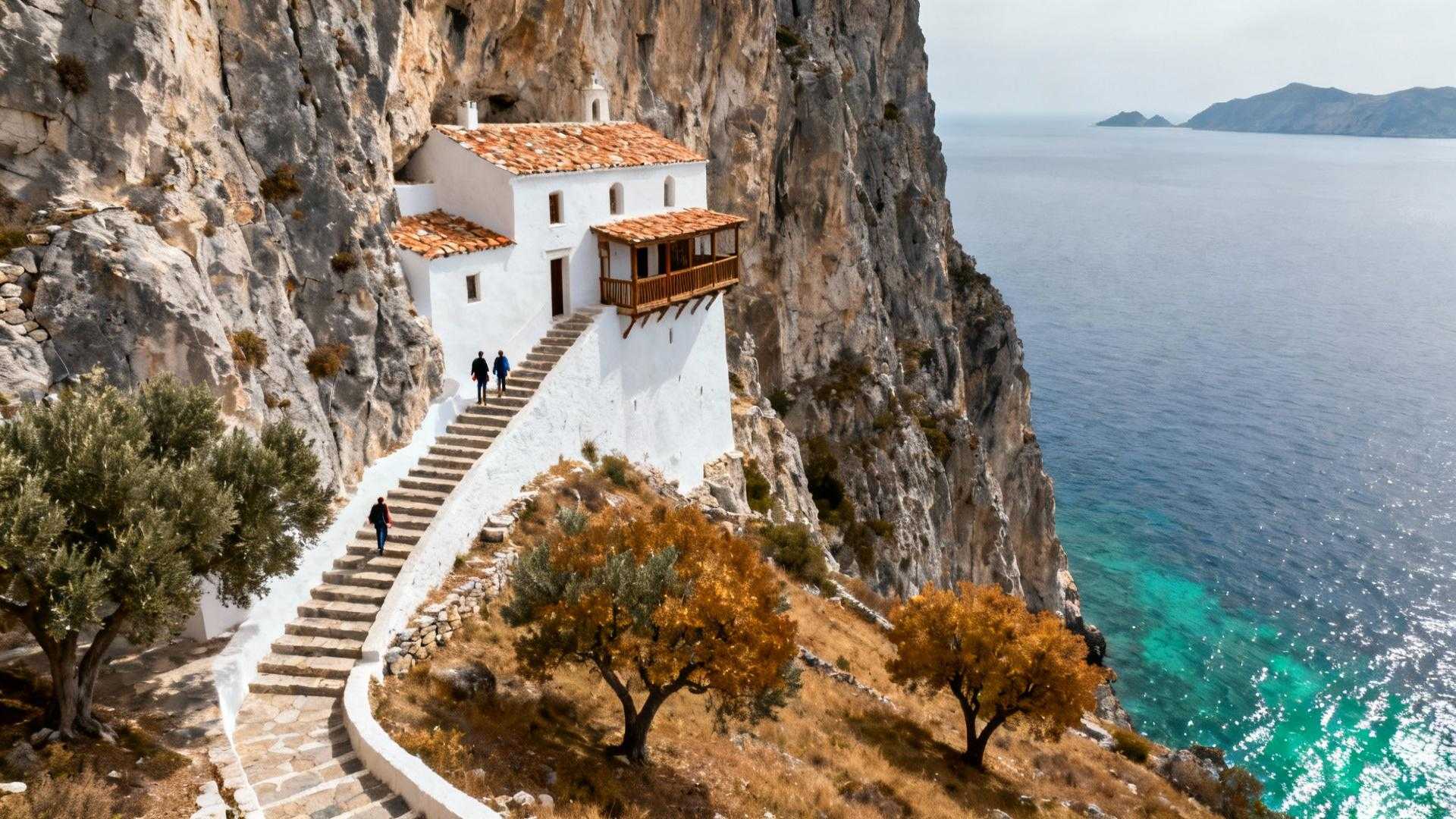I stood at dawn beneath a 300-meter cliff face on Amorgos, watching white walls emerge from rock itself as first light touched the Aegean. While Meteora’s 3 million annual visitors fight for €25 tour tickets and parking spaces at 5am, I’d discovered something Meteora can never claim: the only monastery in Greece literally carved into a cliff face, not built on top of it. The Monastery of Panagia Hozoviotissa doesn’t rest upon rock—it becomes part of the mountain.
This isn’t about choosing between famous and obscure. It’s about understanding why Byzantine architects in 1088 chose to carve eight floors into vertical stone rather than construct atop it, and why that architectural decision creates an experience Meteora’s cliff-top positioning simply cannot replicate.
The architectural impossibility that defies gravity
Eight floors compressed into 5 meters of width
The monastery’s specifications read like a structural engineer’s nightmare: 40 meters tall, maximum 5 meters wide, eight floors connected by staircases carved directly into rock. French explorer Pitton de Tournefort called it a “chest of drawers” hanging from the cliff—an apt description for a building that appears more vertical than architecture should allow. The entrance sits 10 meters above ground, originally accessed by retractable ladder, a medieval security feature that doubles as crowd control even today.
Why carved-into beats built-upon
Meteora’s monasteries perch magnificently atop sandstone pillars, but Panagia Hozoviotissa does something architecturally unique: it integrates with the cliff face itself, using natural rock crevices as structural support. Walking through its 100+ rooms—monks’ cells, refectories, cisterns, libraries—you touch walls that transition seamlessly from carved stone to built masonry. This isn’t construction despite the mountain; it’s construction in collaboration with it.
The living Byzantine tradition commercial tourism hasn’t reached
Four monks preserving 1,000-year Orthodox practices
Currently, only four monks maintain this second-oldest monastery in Greece, continuing prayer cycles established in 813 AD and formalized under Emperor Alexius Comnenus I in 1088. They welcome visitors with cool water, Amorgos raki, and Turkish delight—not as tourist performance but as monastic hospitality tradition. You’ll witness active Orthodox liturgy here, not a museum recreation, and the difference transforms sacred architecture into sacred experience.
Byzantine relics you’ll encounter, not view behind glass
The monastery houses the original icon from Hozova, Palestine—the namesake that connects this Cycladic cliff to Middle Eastern Christianity—plus manuscripts and ecclesiastical artifacts spanning the 10th to 19th centuries. These aren’t roped-off exhibits. They’re part of living worship space where incense still burns and liturgical chants echo through Byzantine arches constructed from porolit stone from Milos island.
The pilgrimage that filters crowds through 271 stone steps
Why vehicle-free access preserves authenticity
There’s no parking lot chaos here, no tour buses idling while guides herd groups. Access requires climbing 271 carved stone steps from the road 1 kilometer outside Chora—a 20-minute ascent that functions as natural crowd filter and spiritual preparation. October’s comfortable 18-24°C temperatures make this climb meditative rather than exhausting, unlike summer’s heat or Meteora’s parking lot scrambles.
The November 21st feast locals protect carefully
The annual Feast of the Presentation of the Virgin Mary on November 20-21 transforms this monastery into island-wide celebration, with the sacred icon processed through every village. Locals guard this tradition fiercely—it’s six weeks away now, creating urgent booking windows for monastery guesthouses. October visitors witness feast preparations: rehearsals, decorating, community engagement that reveals living tradition rather than tourist spectacle.
Practical pilgrimage planning for respectful visitors
Getting there without commercialized tour packages
From Athens, ferry to Naxos or Paros (3-4 hours), then 45-minute ferry to Amorgos—total cost under €50 versus Meteora’s €25+ guided tours that don’t include transport. The monastery maintains strict hours: 8:30am-1pm and 5pm-7pm, with 6am cliff illumination reserved for early risers who arrive at dawn. Similar to Switzerland’s Château de Chillon, which preserves medieval heritage through limited access, Panagia Hozoviotissa uses geographical isolation as preservation tool.
Dress codes as cultural respect, not inconvenience
Men must wear long trousers, women long skirts—requirements enforced at the entrance, not suggested. This isn’t tourism bureaucracy; it’s Orthodox tradition that honors sacred space. Come prepared with modest clothing, and you’ll experience the monastery as pilgrimage site rather than photo backdrop. Like Croatian locals protecting Galesnjak Island from Instagram hordes, Amorgos monks maintain visitor standards that preserve authenticity.
FAQ: Planning your cliff-carved monastery pilgrimage
How does Panagia Hozoviotissa differ from Meteora monasteries?
Panagia Hozoviotissa is carved into the cliff face with rooms integrated into natural rock crevices, while Meteora’s monasteries sit atop sandstone pillars. The architectural distinction creates different spatial experiences—vertical compression versus horizontal expansion—and dramatically different crowd levels (tens versus thousands daily).
What’s the best time to visit for authentic experience?
October through May offers comfortable climbing temperatures and fewer tourists, with the November 20-21 feast providing unparalleled cultural immersion. Dawn visits (arriving at 6am for 8:30am opening) provide solitude before daily visitors arrive, with October’s 7:18am sunrise illuminating the cliff face dramatically.
Can I stay overnight at the monastery?
The monastery offers limited guesthouse accommodations for pilgrims, requiring advance booking—particularly crucial for the November feast period. Unlike Santorini’s Oia, where sunset crowds pay €180 for Byzantine dome views, staying at Panagia Hozoviotissa costs modest donations and grants access to monastic prayer cycles.
Standing on the highest balcony 300 meters above untouched Aegean waters, I understood why this monastery exists uniquely in Greek architecture. It doesn’t dominate the landscape like Meteora’s cliff-top monuments—it surrenders to the mountain’s natural form, becoming inseparable from rock itself. This isn’t just the only cliff-carved monastery in the Cyclades. It’s a 1,000-year lesson in architectural humility that four monks still teach daily, if you’re willing to climb 271 steps to receive it.
